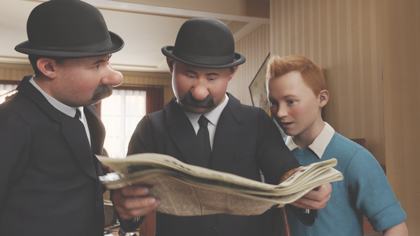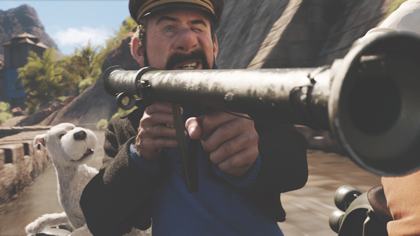Review
The Adventures of Tintin The Secret of the Unicorn

Sumptuously motion-captured and computer-modelled, Steven Spielberg’s big-screen rendition of Hergé’s adventure comics isn’t entirely gripping, finds David Jays
The Adventures of Tintin The Secret of the Unicorn
US 2011
Director: Steven Spielberg
Motion capture cast: Jamie Bell, Andy Serkis, Daniel Craig, Nick Frost, Simon Pegg, Toby Jones, Mackenzie Crook, Daniel Mays, Gad Elmaleh, Joe Starr
107 mins | Cert PG
Synopsis
Our synopses give away the plot in full, including surprise twists.
An unnamed European city in the mid-20th century. Young reporter Tintin buys a model ship called the Unicorn, despite competition from an insistent American and a sinister gentleman named Sakharine. Tintin learns that the Unicorn was a 17th-century warship captained by Sir Francis Haddock, and that Sakharine owns both Marlinspike Hall, the Haddocks’ ancestral home, and another model of the Unicorn. Tintin’s ship is stolen; the American is shot when warning him of danger. Tintin finds a cryptic parchment about Sir Francis’s treasure that had been concealed in his ship’s mast.
There are three model ships, each containing a clue, and Sakharine covets them. Tintin is abducted by the crew of the Karaboudjan, commanded by Sakharine, who has displaced the alcoholic Captain Haddock (a descendant of Sir Francis). Tintin’s dog Snowy releases him, and they escape with Haddock. Tintin captures a plane that attacked them, before crashing in the Sahara. Haddock describes how Sir Francis captured a treasure hoard from the pirate Red Rackham, and realises that Sakharine is Rackham’s descendant, seeking riches and revenge.
In Morocco, Sakharine steals the third clue and returns home. After a showdown at the docks, he is arrested by detectives Thompson and Thompson. The clues lead Tintin and Haddock to the treasure at Marlinspike Hall, but they realise that yet more booty lies drowned and resolve to recover it.
Review
After completing Indiana Jones and the Last Crusade in 1989, Steven Spielberg declared, “I feel as if I’ve graduated from the college of Cliffhanger U.” Tintin, which the director first read during his Indiana Jones years, returns him to this alma mater. Initially written in serial form, the books by Belgian artist Hergé are relentlessly episodic – Tintin and friends repeatedly capture rogues and evade capture, biff and get biffed. It’s not so much a story arc as a pogo, and the rush of imperilled incident is both exciting and exhausting.
In the film, boy reporter Tintin (Jamie Bell) meets alcoholic Captain Haddock and is involved in a search for lost treasure, endangered by the suave villain Ivan Sakharine (Daniel Craig). The elaborate plot for this 3D motion-capture animation draws on the 1943 Tintin story The Secret of the Unicorn, with additions from Red Rackham’s Treasure (1944) and The Crab with the Golden Claws (1941, in which Tintin first encounters his seadog ally).
Spielberg’s British screenwriters have all previously titivated genre tales. Steven Moffat (Doctor Who), Edgar Wright (Shaun of the Dead) and Joe Cornish (Attack the Block) produce lightly sardonic dialogue and dovetailed exposition during Haddock’s thirst-crazed hallucinations in the Sahara. A ship’s rigging rises from the desert sands as he recalls the feud between his ancestor Sir Francis and the ruthless pirate Red Rackham.

After a largely unloved sequel to his Indiana Jones series (The Kingdom of the Crystal Skull, 2008), Tintin’s adventures offer Spielberg the boundless fantasy of animation. Hergé’s books, like the Indiana Jones movies, have been dogged by a fug of racism; Spielberg, working with producer Peter Jackson, treads lightly here, and Tintin’s pith helmet in Morocco is the most explicit nod to colonialism.
The design team whirl Hergé’s elegant, shadowless lines into a sumptuously modelled 3D universe. They celebrate the textures of iron, rust and dust-smeared air, yellowed parchment and throwback engineering. Digital craft burnishes these escapades from a pre-digital age. Bravura action sequences exploit the swooping animator’s eye – soaring from falcon’s-eye view to danger at tarmac level, or thrilling to the flame-licked, tangled rigging of opposed sailing ships. Other scenes have a comic gleam, as a soprano’s ear-bleed coloratura proves a cunning weapon against bulletproof glass.
Motion-capture filming allows naturalistic performances, with faces teased into caricature around nose and chin. Even so, the dauntless protagonist is a problem. While Pixar animations can persuade audiences to invest emotion in a clownfish, toy cowboy or tidy-minded robot, Tintin’s righteous pluck keeps anxiety at bay. A hero who can bring down a plane with a single bullet doesn’t need us to will him on.
His best moment comes in a Spielberg self-reference, as his quiff cuts through the water like the Jaws shark’s fin. More compellingly imagined are Snowy, Tintin’s resourceful white terrier, and the extravagantly flawed Captain Haddock (a loyal but irascible lush with grimy fingernails), richly played by Andy Serkis.
A luxury-tooled fantasy product, the film ends with a now-customary plug for a sequel – Hergé’s original Unicorn serial did the same. But, like the thrill-sapping hero and anti-climactic denouement, it botches the full satisfaction of adrenaline adventure.
See also
French comic-strip mavericks at the movies: Guillaume Gendron on films by French comic-strip artists (August 2010)
Animation timeline (August 2006)
Sky Captain and the World of Tomorrow reviewed by Ben Walters (November 2004)
An eye for an eye: Nick James on Minority Report (August 2002)
A.I. Artificial Intelligence reviewed by Philip Strick (October 2001)
Star Wars Episode 1 The Phantom Menace reviewed by Andrew O’Hehir (July 1999)
Credits
- Director
- Steven Spielberg
- Produced by
- Steven Spielberg
- Peter Jackson
- Kathleen Kennedy
- Screenplay
- Steven Moffat
- Edgar Wright
- Joe Cornish
- Based on The Adventures of Tintin [The Crab with the Golden Claws, The Secret of the Unicorn and Red Rackham’s Treasure] by Hergé
- Edited by
- Michael Kahn
- Art Directors
- Andrew Jones
- Jeff Wisniewski
- Music
- John Williams
- Animation Supervisor
- Jamie Beard
- Visual Effects and Animation
- Weta Digital Ltd
